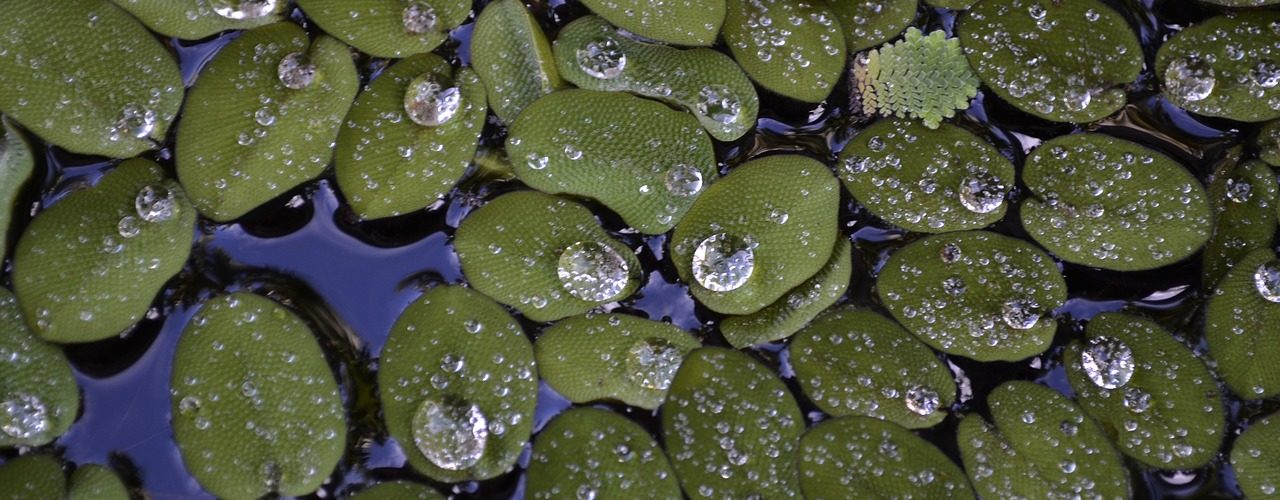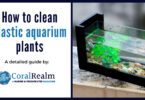Last Updated on February 12, 2023 by Jakob
A freshwater aquarium isn’t complete without plants, and floating aquarium plants are a different way to go rather than rooted plants. They help to bring the magic of an aquarium to life, making the tank look more natural and realistic.
In this article we will sing the praises of floating aquarium plants. We will tell you the benefits of having floating plants in your fish tank, and what you should seriously think about getting some.
If you are looking for a general Floating Plants For Aquarium guide – then we have an article around the general specifics.
After that we will list the best floating aquarium plants you can find, and describe their ideal conditions and how best to keep them. Finally we will end on how to keep your floating aquarium plants happy and healthy.
IN THIS ARTICLE
Reasons to get the best floating aquarium plants
There are many reasons to get floating aquarium plants for your fish tank. We will go over some of the reasons here, but don’t think these are all of them! The benefits of having plants in a fish tank are too numerous to ramble on about in a simple article, but we will anyway!
Provides cover and shade
The best floating aquarium plants are found, surprise surprise, floating on the surface of the fish tank. Most floating plants grow to form mats or large leaves. In the natural environment this is to capture as much sunlight as possible for photosynthesis. It also works to block sunlight and provide cover and shade to the water beneath.
In aquariums the lighting is normally provided by LED lights. While these lights are fantastic, and good LED lighting can provide the correct spectrum to simulate sunlight very effectively, as well as provide moonlight and storm effects.
However some fish like to have low light environments. As do some rooted plants. Too much high intensity lighting can actually have a detrimental effect on these low light organisms. Having floating aquarium plants can help to break up high intensity light, and provide the shade that low light plants especially need to thrive.
Freshwater fish, especially fry and smaller fish such as Guppies and Mollies, love the cover of floating plants. They will often be found hiding and darting in and out of the roots.
Fast growing and easy maintenance
A beautiful thing about aquarium floating plants is that they are so easy to grow and maintain. This is the reason why floating plants are found all across the world. They can cause big problems as invasive species as they are fast growing and out compete the local rivals.
In the aquarium this works to your favor; most of the time you just have to drop them in the tanks, arrange them as you wish, and leave them be. The only maintenance you really have to do is to remove excess growth! With some of the plants on this list, if you leave them to grow uninterrupted they will end up covering the entire surface of the water!
Natural looking aquarium
In our eyes, this is by far the most valid and important reason as to why you should get floating plants for your aquarium.
In every natural freshwater ecosystem there are floating plants to be found in one form or another. Some ecosystems even have carnivorous plants! Therefore bringing a taste of the wild back to your home aquarium helps to increase the natural look and feel of it.
Having an aquarium is a joy, and should be about enjoyment. But you also have a responsibility to the animals and plants that you keep in the tank. Making the aquarium look and feel as natural as possible will help to reduce the stress of your fish, and make them as healthy as they can be. Not only this but your enjoyment of watching your fish will increase as their natural behaviors and personalities come to the fore as they explore their natural wild feeling tank home.
Natural filtration
All plants need nutrients as well as carbon dioxide and light to grow and thrive. Plants take these nutrients from the environment they happen to find themselves in.
While rooted plants take these nutrients from the soil or substrate, floating aquarium plants take the nutrients they need straight from the water column.
Plants need a source of nitrogen and phosphorus, and floating plants will draw ammonium and nitrate from the water column as sources of nitrogen, and phosphate as a source of phosphorus. If you remember from the nitrogen cycle, the conversion of nitrate to organic components is called immobilization.
Ammonium is part of an equilibrium that forms in water with ammonia. Ammonia is incredibly toxic to fish and even low levels will cause ammonia poisoning. When plants remove ammonium it causes more ammonia to change to ammonium, therefore lowering the concentration of ammonia. Nitrate is much less toxic, but in high enough concentrations will cause nitrate poisoning.
Having these compounds removed from the tank will increase the health of your fish.
Having floating plants remove nitrate and phosphate is also important in keeping unwanted algal growth to a minimum. Algae are plants too, so need to get nitrogen and phosphorus from nitrate and phosphate the same as floating plants. Having floating plants use these nutrients means that algae won’t be able to!
Supplements diet
Most freshwater fish are omnivorous, meaning that they will happily eat both animal and plant based food. Therefore they won’t think twice in having a nibble at your floating aquarium plants.
This can help in supplementing the diet of your fish. Don’t rely on this as a main food source though, fish will only eat small bits and pieces. However it can be very good enrichment.
Having floating plants in the aquarium for your fish to nibble at will also take the pressure off any rooted plants you may have. Floating plants are in general tastier to fish, much faster growing and can handle being grazed much more than their rooted counterparts.
12 Best Floating Aquarium Plants

So here we go! Out list of the 12 best floating aquarium plants. Don’t think too much about the order that we have put these plants; all are fantastic floating plants that will look brilliant in any freshwater fish tank.
1) Duckweed (Lemna Minor)
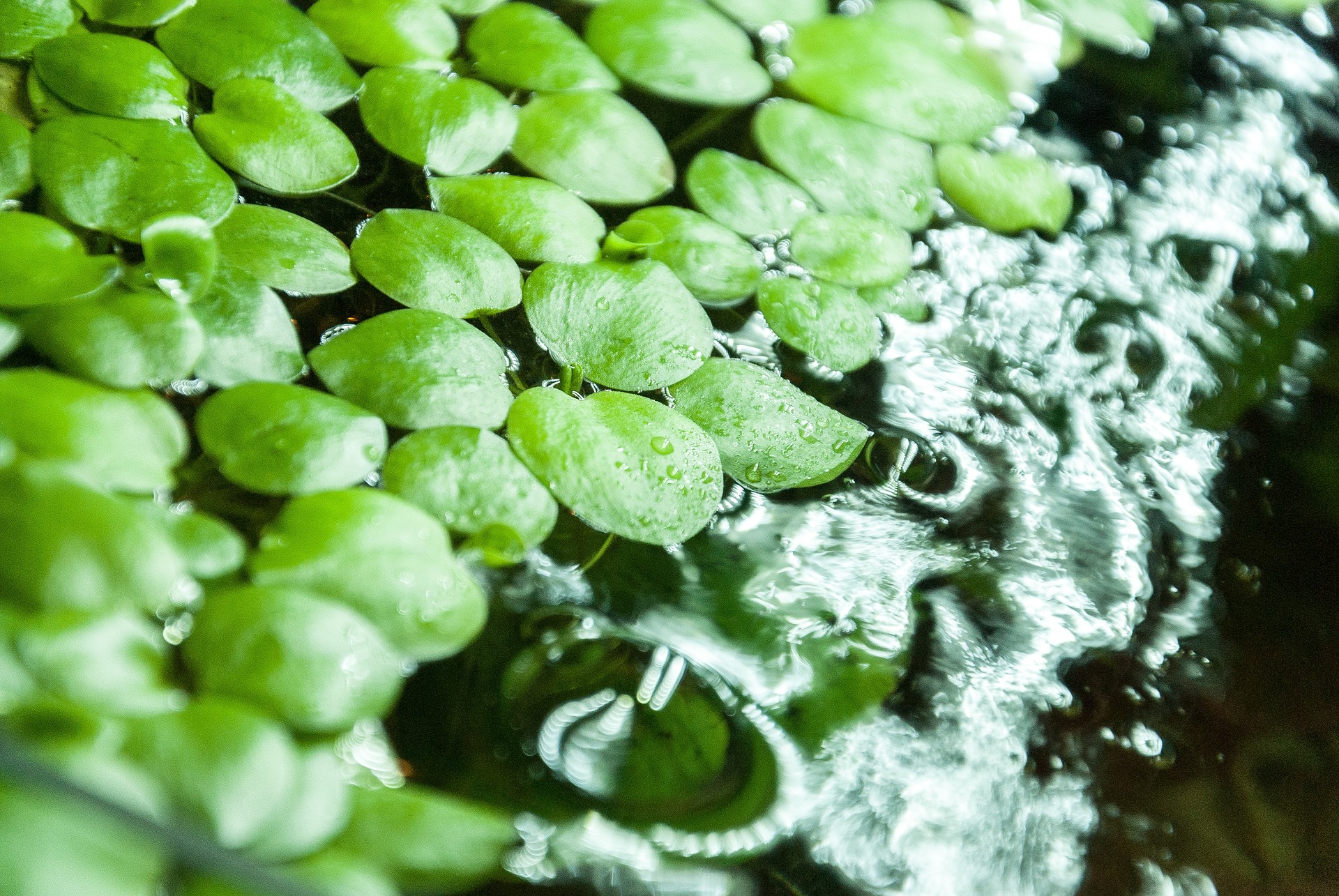
Duckweed is one of the most easily recognizable freshwater floating aquarium plants. In the natural environment it has a subcosmopolitan distribution, meaning it is found basically across the entire world. It is found in lakes, rivers, and ponds, where it grows rapidly across the surface. It has also earned the name water lentils from its easily recognizable small leaves.
There are no real water parameter requirements for Duckweed; the reason why it can be found throughout the world is that it can survive in temperatures of between 43°-91°F, general hardness from 2-15 dGH and carbonate hardness of 1-12 dKH. However for maximum health the pH should be in the range of 6.5-8, and it may need an injection of nitrate or phosphate fertilizer sometimes.
Duckweed’s hardiness isn’t the only reason that we have put it straight into number one on this list. Simply put, it looks incredible in a fish tank. Each small plant has between one and four leaves, which look amazing from above. Even better is a fish-eye view. From below the roots hanging from each plant look stunning, and the light coming from between the leaves look like sunbursts.
Small fish and fry absolutely love Duckweed. It acts as a perfect refuge for them to hide and seek safety from larger, more aggressive fish.
The only downside to Duckweed is that as it is so hardy and so quick growing, it can quickly spread across the entire water surface. For labyrinth fish like Betta fish this isn’t the best. So you do need to regularly scoop out excess Duckweed. If you have a small nano fish tank it can become very regular indeed. However another way of controlling it is to put a floating barrier in the tank so that you contain the Duckweed to one section of the tank.
2) Red Root Floater (Phyllanthus fluitans)
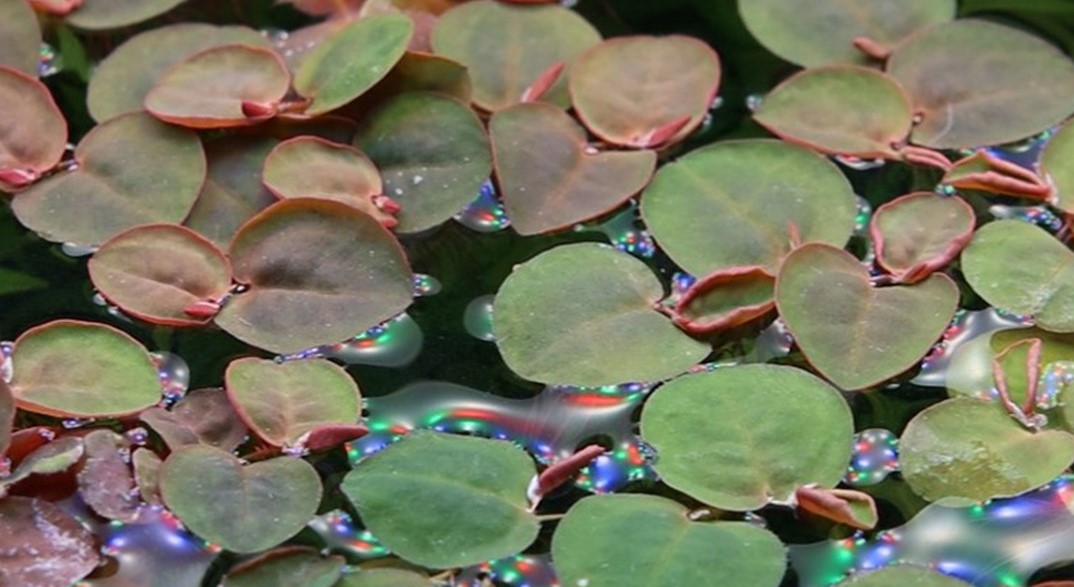
The Red Root Floater is a fantastic looking floating aquarium plant. The red coloration makes it a stunning choice to have as a floating centerpiece.
In any conditions the roots and underside of the leaves are a stunning bright red color, and the leaves range from green to a deep brown/red. The leaves are waxy and water repellent
Red Root Floater prefers a temperature range of between 70°-86°F, a pH range of 5-8, and a general hardness of 0-12 dGH. It is relatively easy to grow and keep. If you want the leaves to be red as well as the underside it needs high intensity lighting. Good quality LED lights which emit the full color spectrum are needed for this.
The other requirement that the Red Root Floater has is that it doesn’t like much surface agitation. If you have a very powerful filter or a powerhead or wave maker to increase water circulation then this plant may not take too kindly to it. This isn’t to say it will die off, just that it may grow slower and be less colorful. For it to look its best it needs low surface movement.
This plant, similarly to Duckweed, grows in a carpeting mat on the surface. Growing in this manner will create lots of shade in the water column, which will help shy fish to come out into the open, as well as creating shelter for young fish and fry.
3) Java Moss (Taxiphyllum barbieri)
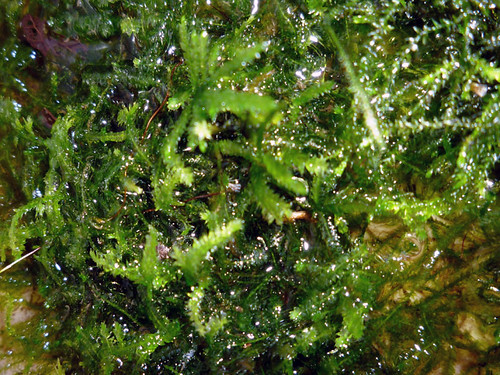
Credit: AJC1 (Flickr)
Java Moss is one of the most popular plants full stop in the aquarist community. It isn’t hard to see why; not only is it a fantastic looking plant but fish and shrimp love it as well.
Java moss is used a lot in aquascaping, making a tank into a stunningly beautiful underwater garden, for its beauty and ease of attachment to different objects.
It is often used as a carpeting plant on the base of a tank, but it is just as easily and readily used as a surface and floating plant. All that you need to do is give it something floating to attach to. Something as simple as a piece of cork works perfectly. But anything non-toxic works just as well. Java Moss doesn’t possess true roots, instead having rhizomes, so while these are attaching to the piece of cork use wire or string to initially attach the Java Moss. Once the rhizomes are attached you can then remove the wire or string if you wish.
Java Moss has small stems and delicate looking leaves. Floating java moss looks fantastic, and you can either let it float around the tank or can keep it anchored in one place. Small fry will love using this moss as a hiding place; the small leaves and stems make a perfect refuge. Fish also will use it as a site to attach their eggs.
You can either trim and cut the plant into a shape to maintain it, or you can let it grow freely, where it will grow gently outwards from its attachment point. Be a little wary of trimmings or the floating plant getting caught in the filter inlet.
Java Moss is a very hardy plant and can survive in temperatures between 60°-86°F, though they prefer a temperature range of 70°-75°F. It likes a pH of between 5 and 8, and a water general hardness of 20 dGH. There is no minimum tank size; as a moss it can be grown even in the smallest of nano tanks.
4) Mosquito Fern (Azolla filiculoides)
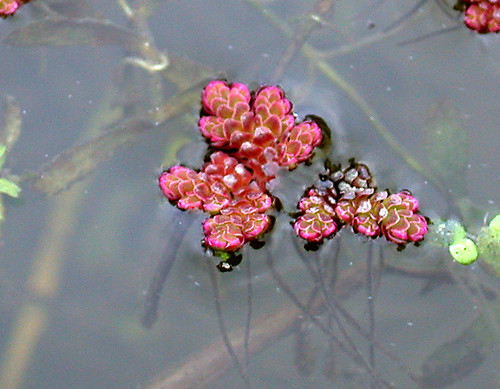
Credit: Len Worthington (Flickr)
Mosquito Fern quite closely resembles Duckweed from a distance; they both have small leaves and form a carpet across the surface. However while Duckweed has between one and four leaves, the Mosquito or Water Fern seems to be made up of many tiny leaves stacked on top of each other, much like the scales of a reptile. These delicate looking leaves look absolutely stunning in any aquarium. The leaves can be green or red.
The Mosquito Fern grows in a carpeting mat across the surface of the aquarium. It is called the Mosquito Fern as even mosquitoes are stopped from laying their eggs! It is very quick growing, and can propagate via fragments as well as by spores. Therefore the same care should be taken as with Duckweed with this floating aquarium plant.
The leaves grow from a single hanging root which provides cover for young fish, and the matting growth provides shade and cover as well.
There aren’t any specific requirements that it needs for growth or color; it can grow in any temperature, pH, and hardness range that your aquarium will be at.
5) Hornwort (Ceratophyllum demersum)
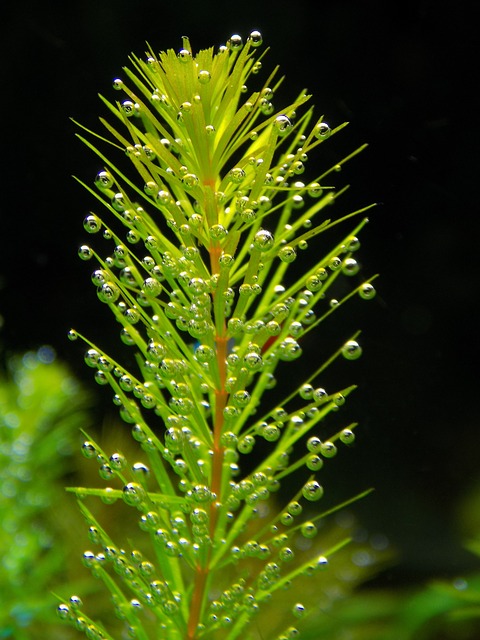 Hornwort is also commonly known as Coontail. It is extremely hardy and can thrive in a very wide range of environmental conditions; this has enabled it to have a cosmopolitan distribution. It is found in all continents except Antarctica. Therefore it is a guarantee that it will thrive happily in your aquarium.
Hornwort is also commonly known as Coontail. It is extremely hardy and can thrive in a very wide range of environmental conditions; this has enabled it to have a cosmopolitan distribution. It is found in all continents except Antarctica. Therefore it is a guarantee that it will thrive happily in your aquarium.
This hardiness and ease of growing makes Hornwort a perfect floating aquarium plant for beginner aquarists looking for a species which won’t take much time to care for or maintain. Maintaining a floating Hornwort is incredibly easy; as it doesn’t have true roots it can simply be left to float on the surface, and it can easily be trimmed if it gets too long.
Most freshwater fish, especially surface dwelling fish, do extremely well in a tank with floating Hornwort. Fish can often be seen swimming in and out of the fronds, which offer a perfect shelter for small and young fish. Shrimp love Hornwort as well, and it can help to bring reclusive shrimp out in the open.
Hornwort is incredibly hardy, and is almost guaranteed to thrive in any aquarium. As such there aren’t any specific water conditions it needs. For optimal growth though it needs a temperature range of 59°-86°F, a pH of 6-7.5, and a general hardness of 3-17 dGH.
The one downside is that it does tend to shed its needle quite a lot, especially when you first put it into a new tank. Don’t worry even if a high percentage of the needles fall off; they will come back. But you will need to use an aquarium vacuum cleaner to clean up the fallen needles. Each needle can potentially grow an entire new plant!
6) Floating Bladderwort (Utricularia sp.)
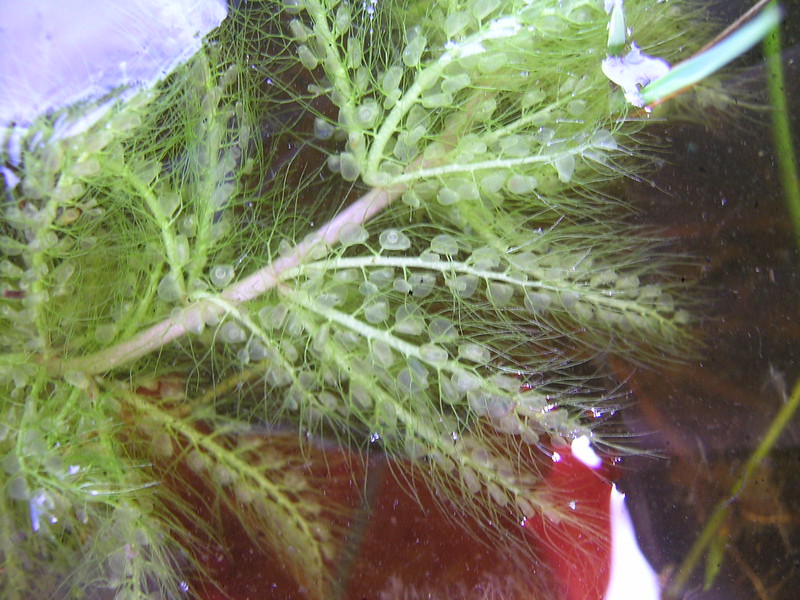
Credit: Harry Rose (Flickr)
is an incredibly cool floating aquarium plant to have in a fish tank. It is the only one on this list which is an aquatic carnivorous plant!
Species in the Utricularia genus are collectively known as floating bladderwort. They are small floating, mat-forming species which have small bladder-like traps to capture zooplankton such as daphnia. So no need to worry; they won’t be munching on your fish any time soon!
The bladder traps work by creating a vacuum in the inside of the bladder trap. When the trap closes, the center is full of water. This water is pumped out of the trap via active transport. The walls of the bladder suck in as the pressure increases; the inside is empty, and has lots of potential energy. When prey springs the trap, the door opens and water and the prey flood into the trap. Trapping prey in this way evolved so Bladderwort could survive in nutrient-poor conditions that other plants couldn’t handle. Prey provides a source of nitrogen and phosphorus.
Floating Bladderwort will also produce small yellow flowers in the tank. These will bring a real spark of light to the top of your tank.
Do be wary though, as Bladderwort is very fast growing and can look fairly tangled in an aquarium. However with a bit of maintenance it can be a real talking point. As they naturally thrive in nutrient poor conditions, water with a high nutrient load may throw it off a little. But it is a hardy plant that will grow in a very wide range of conditions; naturally it can be found on every continent except Antarctica.
7) Water Wisteria (Hygrophila difformis)
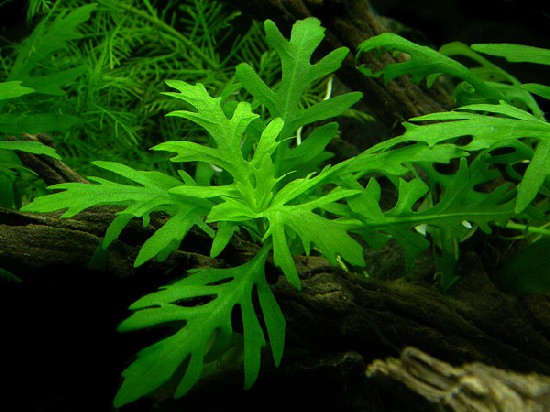
Water Wisteria is an incredibly popular freshwater aquarium plant. It is perfectly happy both as a rooted plant and as a floating aquarium plant. This flexibility allows it to be used in any number of different freshwater tank setups.
The tall leaves have a lace-like quality which will look brilliant in your tank. When Water Wisteria is grown as a floating plant it grows outwards and across the surface of the water. This creates a blanketing mat effect which provides perfect cover for young and shy fish. It is also a perfect environment for shrimp to explore.
Water Wisteria work perfectly as floating aquarium plants, as they require high intensity lighting. Being on the surface closer to the LED light means you can be sure it will get the light it needs. It also prefers a water temperature of between 70°-82°F, a pH range of 6.5-7.5, and a water general hardness of 5-15 dGH.
Water Wisteria is very fast growing, and can quickly grow to cover the surface. It needs to be trimmed quite regularly to keep the growth in check.
8) Amazon Frogbit (Limnobium laevigatum)
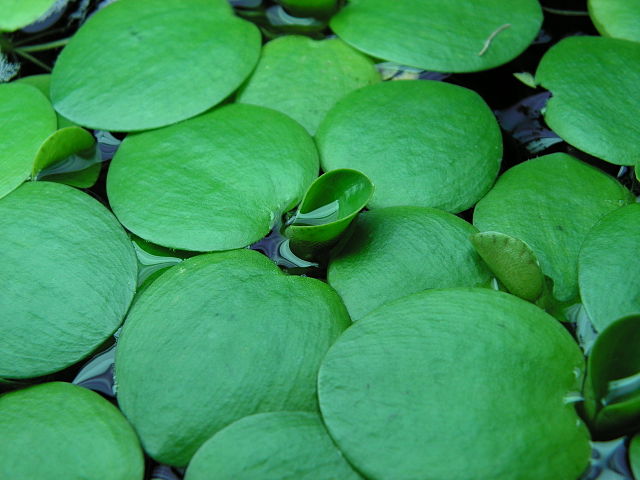
Amazon Frogbit is found naturally throughout Central and South America. It is one of the more popular floating aquarium plants as it looks like a miniature lilipad.
The roots of Amazon Frogbit can grow up to 20 inches long, and the leaves have a width of 0.5 to 3 inches. When the plant is young the leaves will lie flat to the water’s surface, while when mature they will have some which are slightly raised from the surface as well. Amazon Frogbit will produce small white flowers which complement the small green pads perfectly.
While Amazon Frogbit is very easy to care for it will start to rot if water gets on the top of the pads. If you see water droplets on the top of the pads or the pads getting dragged underwater you should make sure to shake them off and have them lie flat again. Snails will like to eat the softer underside of the pads; keeping the pads away from the side of the tank will help with this.
Amazon Frogbit will grow best within a temperature range of 64°-84°F, a pH range of 6.0-7.5, a general hardness of 0-30 dGH, a carbonate hardness of 0-14 dKH, and medium lighting. As the roots can grow very long, they do need a tank of at least 20 gallons in order to have enough space to grow properly. Trimming and thinning of Amazon Frogbit should be done to ensure it doesn’t grow across the entire surface.
9) Brazilian Pennywort (Hydrocotyle leucocephala)
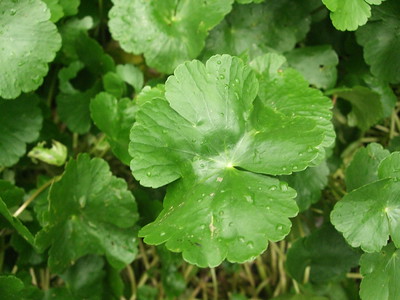
Credit: 石川 Shihchuan (Flickr)
Brazilian Pennywort is another South American floating aquatic plant which does very well in aquaria. Large green leaves are produced which are spaced apart from each other. These will grow across the surface as well as above it. It will also grow up the sides of the tank!
On average the leaves are the size of a quarter, but more mature leaves can grow larger. The leaves are round and have almost a “cut” look to them,with a slit from the center, and have prominent veins running through them. The leaves will grow from a tendril like stem. They look fantastic in any freshwater tank.
Brazilian Pennywort can grow in almost any temperature, needing a range of 41°-86°F. It prefers a pH range of 6-7, a carbonate hardness of 2-15 dKH, and a general hardness of 0-30 dGH. It doesn’t have any lighting or CO2 requirements. It is very fast growing so regular trimming will be needed.
10) Water Spangles (Salvinia minima)
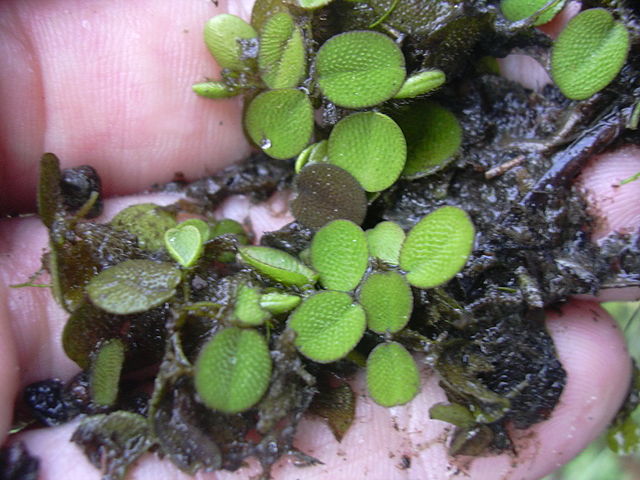
Credit: Forest & Kim Starr, CC BY 3.0, (WikiCommons)
Central and South America has produced another gem in Water Spangles. It is up there with the best looking floating aquarium plants. The floating leaves look like lily pads, and are round to oval in shape. The leaves get to around just over half an inch in length. Stems of Water Spangles grow to around four inches before breaking off and forming new plants.
The roots of Water Spangles hang quite low and are a perfect refuge for small and young fish, bringing them out of hiding.
Water Spangles prefer a temperature range of 65°-89°F, a pH range of 5-8, a general hardness of 0-30 dGH, and a carbonate hardness of 0-21 dKH. Under conditions outside of these ranges the leaves tend to be a lot smaller.
This floating plant also prefers lower water movement. It grows very quickly, so care is need to ensure it doesn’t become overgrown.
11) Rotala Indica
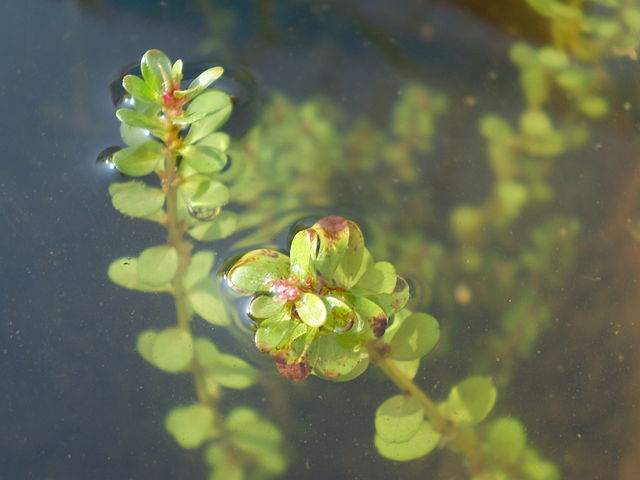
Credit: Show_ryu, CC BY 3.0, (WikiCommons)
Rotala Indica is not a hugely popular aquarium plant, but it is an very beautiful plant. It is more commonly found planted in the substrate, but can be floated as well.
Rotala Indica is native to South East Asia and has waxy green leaves that have a reddish tint on the underside. Under high intensity lighting the reddish color becomes more prominent throughout the leaf. The reasonably large leaves provide a brilliant hiding place for shy fish, and the action of swimming amongst the leaves means you will see a flash of the red coloration from the bottom of the leaves.
Rotala Indica can be left to grow as it wishes. It will become quite large and bushy, or you can choose to keep it trimmed down and nice and neat. It is up to you and the look you are going for in your freshwater tank setup.
In terms of water conditions, it needs a temperature range of 64.5°-86°F, a pH range of 5-7, a general hardness of 0-30 dGH, and a carbonate hardness of 0-14 dKH.
12) Cabomba aquatica
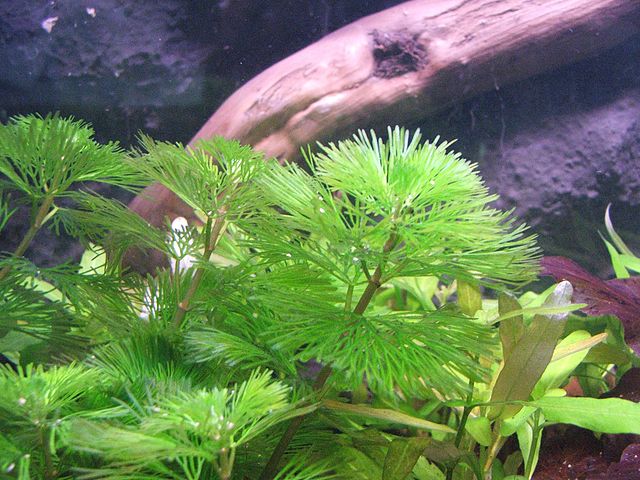
Credit: Piotr Kuczynski, CC BY 3.0, (WikiCommons)
Cabomba has very fine, long, thin leaves which will wave in the flow of the aquarium. It deserves to be in this list of the best floating aquarium plants.
There are a few different species of Cabomba which have different colorations; green, red, and purple. Green is by far the most common color variant and is the easiest to grow, manage, and keep healthy.
It is another plant which is just as happy floating on the surface as it is planted in the substrate. Species of Cabomba can grow up to 20 inches high, and the leaves can stretch to 3.5 inches wide. Therefore it is best displayed in larger tanks where it can grow to its full potential.
The optimum conditions for growing Cabomba are a temperature range of 73.4°-80.6°F, a pH range of 6.8-7.5, and also prefers high lighting.
13) Dwarf Water Lettuce
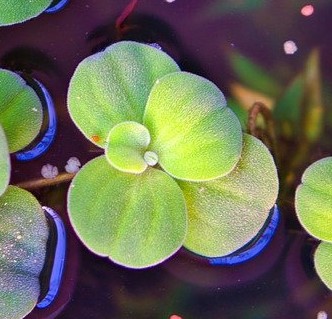
Dwarf Water Lettuce is a stunning plant which has the honor of ending this list of best floating aquarium plants. Whether the best has been saved for last is up to you!
Beautiful light green leaves have many parallel veins and have a covering of short fine hairs. The roots can extend into the tank for about a foot. Freshwater fish love to play and use these roots as a column around which to swim. Flowers can form in the center of the ring of leaves, and if fertilization is successful, unlikely in a tank environment, then fruits will form as well.
It is a tropical plant and needs warm temperatures of between 72°-86°F. It needs a pH of between 6-7.5, and a general hardness of 3-8 dGH. If the general hardness is above 12 dGH stunts the growth Dwarf Water Lettuce.
As the growth rate is very high, and the roots of the Dwarf Water Lettuce extends down into the tank for a foot, a tank size of at least 20 gallons is recommended for this plant. However we recommend a 30 gallon tank minimum to realize the full potential of Dwarf Water Lettuce.
How to Keep Floating Aquarium Plants Healthy
Keeping your floating aquarium plants healthy isn’t too hard a job.
As they are on the surface of the water they are as close to the light source as they can get, so all you need to do is ensure the lighting system you have installed is on for the required time and they will get plenty of light.
However there are a couple things that you do need to keep an eye out for. As they draw nutrients straight from the water column, if the nutrient levels get too low and are used up then the plants could begin to show signs of malnutrition. These signs include browning and wilting of stems and leaves. You can easily check the nutrient levels in your tank using an aquarium test kit, something like the two below.
To increase nutrient levels you can use an aquarium plant fertilizer. There are solid and liquid plant fertilizers available; for floating aquarium plants you will need the liquid fertilizer. A brilliant fertilizer is the Thrive+ All In One Liquid Fertilizer
Another essential piece of maintenance that you need to be aware of with floating plants is that as they are so fast growing, you need to keep an eye on if they are growing too much! A plant spreading across the water’s surface is all well and good, but you don’t want the surface completely covered!
How to Choose the Best Floating Aquarium Plants
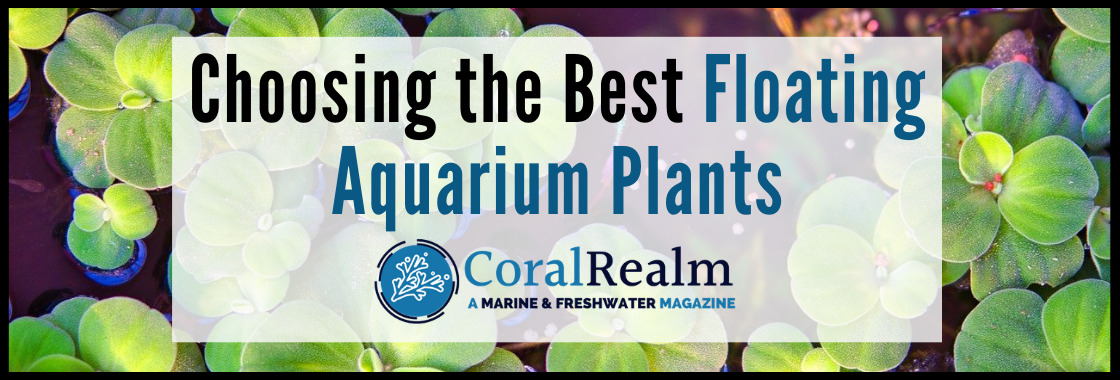
If you’ve read this list and are still none the wiser as to which floating aquarium plant that you should get, then hopefully we can clear it up for you a little bit. Firstly, only get a floating plant that you actually like the look of! Once you know what kind of look you want, you can narrow it down from there. There are a few things that you should check, that you can see from the list below.
Water parameters
You should check what the water parameters that your tank has, and what the fish that you have need. There is no sense in getting an aquatic floating plant that doesn’t grow well in the water parameters that your fish tank currently has.
The water parameters you should check are temperature, general hardness, carbonate hardness, and pH.
Tank mates
This is perhaps the least important of the reasons to get or not get a floating plant, as most freshwater fish will happily live with them. However there are certain fish that you do need to be quite careful with.
Labyrinth fish are the most obvious. These fish possess a labyrinth organ which allows them to breathe air as well as water, and they therefore need easy access to the surface to feel completely comfortable. The most famous labyrinth fish are Betta fish, but Gouramis are labyrinth fish as well.
These fish can be with floating plants such as Hornwort and Dwarf Water Lettuce, as these plants won’t completely cover the surface and can be easily controlled. However plants such as Duckweed aren’t a great idea as they will quickly cover the entire surface if you look away for too long! For a list of appropriate plants, read our guide to the best Betta fish plants.
Lighting requirements
Normally the lighting requirements of aquarium plants is a major point of whether they will be a fit in a tank or not. However this is less of an issue with floating aquarium plants as they are so close to the lighting, growing on the water’s surface.
Some floating plants however, like the Red Root Floater, need high lighting of the correct spectrum. A basic light may not meet these requirements, but a good LED light will. Specialist freshwater LED lights are designed to emit the light spectrum required for photosynthesis.
Tank size and growth rate
Many floating aquarium plants don’t have a minimum tank size that they need, but some, like the Dwarf Water Lettuce, do. Check what size your aquarium is and whether the floating plant you like will be a good fit in that sized tank.
There are also some plants, like Duckweed, that while they will happily grow in any tank of any size, they may be better suited for larger tanks. This due to the growth rate and manner of growth of Duckweed means that it will quickly cover the surface of a small 5 gallon tank for instance, and you will have to be constantly removing excess growth.
Conclusion
Hopefully this complete guide to the best floating aquarium plants has been helpful and informative.
You should now know what to look for in a floating aquatic plant; namely what water parameters you tank has and choose accordingly.
Floating aquariums plants are a brilliant addition to any freshwater fish tank. There is a choice available for tanks of all sizes, so there is no excuse in not livening up your aquarium! You will see the behavioral changes in fish if you decide to go for one, after all it makes a tank more natural, so you get to see the natural behaviors come out!

